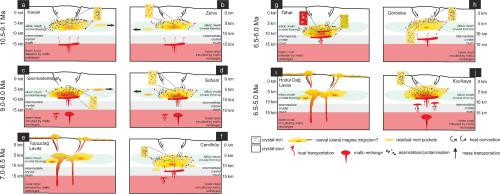当前位置:
X-MOL 学术
›
Gondwana Res.
›
论文详情
Our official English website, www.x-mol.net, welcomes your
feedback! (Note: you will need to create a separate account there.)
Zircon geochronology and O Hf isotopes of Cappadocian ignimbrites: New insights into continental crustal architecture underneath the Central Anatolian Volcanic Province, Turkey
Gondwana Research ( IF 7.2 ) Pub Date : 2021-03-01 , DOI: 10.1016/j.gr.2020.12.003 Lutfiye Akin , Erkan Aydar , Axel K. Schmitt , H. Evren Çubukçu , Axel Gerdes
Gondwana Research ( IF 7.2 ) Pub Date : 2021-03-01 , DOI: 10.1016/j.gr.2020.12.003 Lutfiye Akin , Erkan Aydar , Axel K. Schmitt , H. Evren Çubukçu , Axel Gerdes

|
Abstract During the Mio–Pliocene between ca. 10 and 5 Ma, the Central Anatolian Volcanic Province (CAVP) formed as the focus of a high eruptive flux episode with voluminous high-silica, caldera-forming eruptions. Magmatic compositions of ignimbrites emplaced during this episode were uniformly rhyodacitic–rhyolitic, reflecting melt generation in an intracrustal hot zone heated by intrusions of basalt that were extracted from fertile asthenospheric mantle undergoing decompression. The clear imprint of crustal rocks on CAVP magmas provides unique opportunity to constrain the deep crustal architecture of the central Anatolia. Here, we present detailed study of zircon from key CAVP ignimbrites including U Pb ages and the first coupled O- and Hf-isotopic compositions for this silicic igneous province, along with complementary whole-rock Nd isotope data. Ignimbrites with higher δ18O and lower eHf values (Zelve, Cemilkoy, Gordeles) are typically compositionally more evolved compared to those with intermediate (Kavak, Kizilkaya) and more mantle-like compositions (Sarimadentepe, Sofular, Tahar), which is consistent with magmas acquiring their isotopic compositions through crustal assimilation coupled with fractional crystallization. Intriguingly, O-Hf-zircon compositions from Kizilkaya ignimbrite, one of the largest and youngest CAVP eruptions, cover almost the same isotopic range than all CAVP ignimbrites collectively. Despite evidence for a significant crustal influence revealed by O-Nd-Hf isotopic compositions of CAVP ignimbrites, inherited zircon is absent in all units. This is in stark contrast with previous studies of Kizilkaya ignimbrite for which abundant Proterozoic–Archean zircon populations have been reported. Isotopic compositions of evolved magmas in the CAVP can be explained by interaction of mantle-derived basalt with post-Archean crust, with minor contributions of hydrothermally altered rocks. No tangible evidence exists for a magmatic contribution of Archean crustal components to the Mio–Pliocene ignimbrite flare-up in Central Anatolia, suggesting that regional basement rocks largely represent Gondwanan crust that was originally consolidated and subsequently became reprocessed during post-Archean times.
中文翻译:

卡帕多奇亚火山岩的锆石年代学和 O Hf 同位素:对土耳其安纳托利亚中部火山省下方大陆地壳结构的新见解
摘要在大约在 Mio-上新世之间。10 马和 5 马,安纳托利亚中部火山省 (CAVP) 形成了高喷发通量事件的焦点,其中包含大量高硅、火山口形成喷发。在这一事件中形成的熔凝灰岩的岩浆成分是均匀的流纹英石-流纹质,反映了地壳内热区中的熔体生成,该热区由玄武岩侵入体加热,玄武岩侵入体从肥沃的软流圈地幔中提取,进行减压。CAVP 岩浆上地壳岩石的清晰印记为限制安纳托利亚中部的深层地壳结构提供了独特的机会。在这里,我们详细介绍了来自关键 CAVP 熔凝灰岩的锆石研究,包括 U Pb 年龄和该硅质火成岩省的第一个耦合 O 和 Hf 同位素组成,以及补充的全岩 Nd 同位素数据。与具有中等成分(Kavak、Kizilkaya)和更类似地幔的成分(Sarimadentepe、Sofular、Tahar)相比,具有较高 δ18O 和较低 eHf 值的引燃岩(Zelve、Cemilkoy、Gordeles)在成分上通常更进化它们的同位素组成通过地壳同化与分步结晶相结合。有趣的是,来自最大和最年轻的 CAVP 喷发之一的 Kizilkaya 火山灰岩的 O-Hf-锆石成分覆盖的同位素范围几乎与所有 CAVP 火山灰岩的总同位素范围相同。尽管有证据表明 CAVP 熔凝灰岩的 O-Nd-Hf 同位素组成具有显着的地壳影响,但所有单元中都不存在继承的锆石。这与之前对 Kizilkaya 火山熔岩的研究形成了鲜明的对比,其中已经报道了丰富的元古代-太古代锆石种群。CAVP 中演化岩浆的同位素组成可以通过地幔玄武岩与太古代后地壳的相互作用来解释,热液蚀变岩的贡献很小。没有确凿的证据表明太古代地壳成分对安纳托利亚中部 Mio-上新世熔凝灰岩爆发的岩浆贡献存在,这表明区域基底岩石主要代表冈瓦纳地壳,该地壳最初在后太古代时期被固结并随后被再加工。热液蚀变岩石的贡献很小。没有确凿的证据表明太古代地壳成分对安纳托利亚中部 Mio-上新世熔凝灰岩爆发的岩浆贡献存在,这表明区域基底岩石主要代表冈瓦纳地壳,该地壳最初在后太古代时期被固结并随后被再加工。热液蚀变岩石的贡献很小。没有确凿的证据表明太古代地壳成分对安纳托利亚中部 Mio-上新世 ignimbrite 爆发的岩浆贡献,表明区域基底岩石主要代表冈瓦纳地壳,最初在太古代时期被固结,随后被再加工。
更新日期:2021-03-01
中文翻译:

卡帕多奇亚火山岩的锆石年代学和 O Hf 同位素:对土耳其安纳托利亚中部火山省下方大陆地壳结构的新见解
摘要在大约在 Mio-上新世之间。10 马和 5 马,安纳托利亚中部火山省 (CAVP) 形成了高喷发通量事件的焦点,其中包含大量高硅、火山口形成喷发。在这一事件中形成的熔凝灰岩的岩浆成分是均匀的流纹英石-流纹质,反映了地壳内热区中的熔体生成,该热区由玄武岩侵入体加热,玄武岩侵入体从肥沃的软流圈地幔中提取,进行减压。CAVP 岩浆上地壳岩石的清晰印记为限制安纳托利亚中部的深层地壳结构提供了独特的机会。在这里,我们详细介绍了来自关键 CAVP 熔凝灰岩的锆石研究,包括 U Pb 年龄和该硅质火成岩省的第一个耦合 O 和 Hf 同位素组成,以及补充的全岩 Nd 同位素数据。与具有中等成分(Kavak、Kizilkaya)和更类似地幔的成分(Sarimadentepe、Sofular、Tahar)相比,具有较高 δ18O 和较低 eHf 值的引燃岩(Zelve、Cemilkoy、Gordeles)在成分上通常更进化它们的同位素组成通过地壳同化与分步结晶相结合。有趣的是,来自最大和最年轻的 CAVP 喷发之一的 Kizilkaya 火山灰岩的 O-Hf-锆石成分覆盖的同位素范围几乎与所有 CAVP 火山灰岩的总同位素范围相同。尽管有证据表明 CAVP 熔凝灰岩的 O-Nd-Hf 同位素组成具有显着的地壳影响,但所有单元中都不存在继承的锆石。这与之前对 Kizilkaya 火山熔岩的研究形成了鲜明的对比,其中已经报道了丰富的元古代-太古代锆石种群。CAVP 中演化岩浆的同位素组成可以通过地幔玄武岩与太古代后地壳的相互作用来解释,热液蚀变岩的贡献很小。没有确凿的证据表明太古代地壳成分对安纳托利亚中部 Mio-上新世熔凝灰岩爆发的岩浆贡献存在,这表明区域基底岩石主要代表冈瓦纳地壳,该地壳最初在后太古代时期被固结并随后被再加工。热液蚀变岩石的贡献很小。没有确凿的证据表明太古代地壳成分对安纳托利亚中部 Mio-上新世熔凝灰岩爆发的岩浆贡献存在,这表明区域基底岩石主要代表冈瓦纳地壳,该地壳最初在后太古代时期被固结并随后被再加工。热液蚀变岩石的贡献很小。没有确凿的证据表明太古代地壳成分对安纳托利亚中部 Mio-上新世 ignimbrite 爆发的岩浆贡献,表明区域基底岩石主要代表冈瓦纳地壳,最初在太古代时期被固结,随后被再加工。











































 京公网安备 11010802027423号
京公网安备 11010802027423号